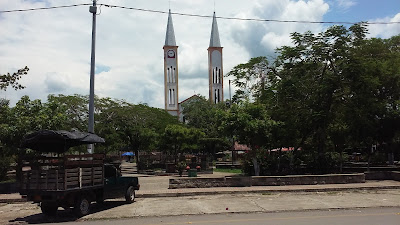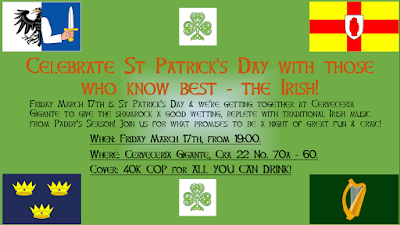As we've mentioned before here, Colombia's popularity as a tourist destination has never been higher. The country is very much in fashion, not just among backpacking types but for a range of tourists.
In many ways, it could be argued, we're just at the start of this upward swing. The potential for sustained growth in this sector appears substantial, like the size of the country itself (for the record, of Colombia's 32 departments, four are bigger in area than the island of Ireland).
We already have fairly well-established areas such as Cartagena, Santa Marta and their surrounds on the Caribbean coast, the Eje Cafetero (coffee region), Medellín and the capital city Bogotá to name the most obvious.
There are other areas, however, that are practically virgin territory when it comes to tourism, and more or less anything else for that matter. Vast tracts of the previously written about Caquetá and Putumayo, for example, fall into that category.
Another department that has plenty to boast about but is rarely even considered as a place to visit is Arauca on the eastern extremes, bordering Venezuela. It's part of Colombia's vast Llanos or plains; in over-simplified terms, cowboy country.
As has been the case with most of the country's other more remote locations, one big reason why tourists, both those from inside and outside, were reluctant to visit was down to the internal conflict. Now, however, with the Farc and paramilitary problems fading post the peace agreement, the associated security concerns are also abating.
What's more, in this air of optimism circling around Colombia, coming from both near and far, everybody's looking to get some warmth (strike it rich, we could say) from this new positive light. And why not?
To this end, those working in Arauca's fledgling tourism sector certainly don't lack energy and enthusiasm. The problem, though, is getting their message out to a wider audience in a country full of beauty spots, varied as many of them are. Other Colombians are unaware of the region's attractions, never mind outsiders.
As Carlos Alberto Duque, the creator of the Colombia Realismo Mágico slogan and who realises the tourism potential Arauca has, puts it: "Each place has sights to show off, a story to tell, but not many are good at getting the message out there."
Arauca's location doesn't help either. By bus, it's a good 12-hour trip from Bogotá just to reach its borders and, on the way, the argument could be made that you pass places more or less equal in terms of landscape and culture. Coupled with this is the fact that, for many backpacking types, it's unnecessarily off the beaten track, basically a 'road to nowhere', considering Venezuela is off-limits for most right now.
That aside, while our short visit to Tame was mostly taken up with the town's annual festival, the all-round tourism pull the place has is evident.
For starters, what's a negative is also a positive. Not many tourists come here, so as tends to happen in such places, the locals are even friendlier than the Colombian norm. There also doesn't appear to be any 'gringo prices' in operation.
For bird watchers, the region is fluttering with delights. Indeed, its wildlife in general is a big selling point (and a reason why we'll be keen to return to go on the look for caiman, giant turtles and monkeys to name just a few).
 |
| 'You are now entering Tame, Arauca.' (Photo from Facebook.) |
There are other areas, however, that are practically virgin territory when it comes to tourism, and more or less anything else for that matter. Vast tracts of the previously written about Caquetá and Putumayo, for example, fall into that category.
Another department that has plenty to boast about but is rarely even considered as a place to visit is Arauca on the eastern extremes, bordering Venezuela. It's part of Colombia's vast Llanos or plains; in over-simplified terms, cowboy country.
As has been the case with most of the country's other more remote locations, one big reason why tourists, both those from inside and outside, were reluctant to visit was down to the internal conflict. Now, however, with the Farc and paramilitary problems fading post the peace agreement, the associated security concerns are also abating.
What's more, in this air of optimism circling around Colombia, coming from both near and far, everybody's looking to get some warmth (strike it rich, we could say) from this new positive light. And why not?
 |
| Tame's historical role in Colombia is evident. (Photo from Facebook.) |
As Carlos Alberto Duque, the creator of the Colombia Realismo Mágico slogan and who realises the tourism potential Arauca has, puts it: "Each place has sights to show off, a story to tell, but not many are good at getting the message out there."
Arauca's location doesn't help either. By bus, it's a good 12-hour trip from Bogotá just to reach its borders and, on the way, the argument could be made that you pass places more or less equal in terms of landscape and culture. Coupled with this is the fact that, for many backpacking types, it's unnecessarily off the beaten track, basically a 'road to nowhere', considering Venezuela is off-limits for most right now.
That aside, while our short visit to Tame was mostly taken up with the town's annual festival, the all-round tourism pull the place has is evident.
For starters, what's a negative is also a positive. Not many tourists come here, so as tends to happen in such places, the locals are even friendlier than the Colombian norm. There also doesn't appear to be any 'gringo prices' in operation.
 |
| Some of Tame's, um, impressive sights ... |
Throw in the fact that over half the area of the Sierra Nevada del Cocuy National Park, home to Colombia's third highest peak, is situated in Arauca and nature lovers have plenty of reasons to visit.
From a cultural point of view, outside of the cowboy and meat-eating lifestyle, there is an indigenous influence in certain aspects, something that the locals seem eager to enhance and promote.
From a cultural point of view, outside of the cowboy and meat-eating lifestyle, there is an indigenous influence in certain aspects, something that the locals seem eager to enhance and promote.
Tame itself is known as the 'cradle of freedom' (cuna de libertad), the place where Latin America's great liberators Simón Bolívar and General Francisco de Paula Santander met for the first time, just weeks before the decisive Battle of Boyacá in 1819. This is honoured with an impressive monument of the two men seated in conversation.
Another not-very-well-known attraction is Arauca's cacao. The department is actually home to award-winning chocolate on an international level. Chocolate could become for the region what coffee is for the Eje Cafetero, which draws tourists all year round.
Specifically, in relation to the town of Tame, its climate is relatively fresh for a low-lying tropical region. So even with temperatures over 30 degrees Celsius, it doesn't feel overbearing thanks to the refreshing breeze blowing about.
With plans afoot to develop a 'Ruta de los Llanos', basically a multi-departmental tourism-focused way through the plains, Arauca's delights could be set to become more accessible and widely known.
An 'Arauca awakening' of sorts. You read it here first!
Another not-very-well-known attraction is Arauca's cacao. The department is actually home to award-winning chocolate on an international level. Chocolate could become for the region what coffee is for the Eje Cafetero, which draws tourists all year round.
Specifically, in relation to the town of Tame, its climate is relatively fresh for a low-lying tropical region. So even with temperatures over 30 degrees Celsius, it doesn't feel overbearing thanks to the refreshing breeze blowing about.
With plans afoot to develop a 'Ruta de los Llanos', basically a multi-departmental tourism-focused way through the plains, Arauca's delights could be set to become more accessible and widely known.
An 'Arauca awakening' of sorts. You read it here first!
_______________________________________



